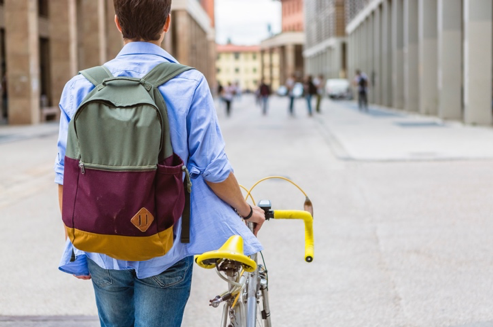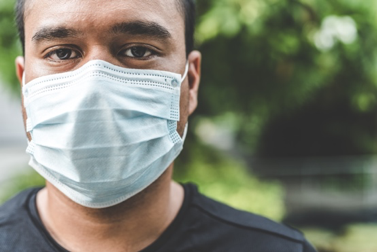Supporting Graduate Students' Academic and Professional Success

Lots of universities have announced plans to reopen their campuses next fall after more than a year of virtual instruction amid the COVID-19 pandemic. This includes the University of California system; with COVID-19 vaccines available to students, faculty, and staff, our campus also announced that it plans to bring most students to campus for in-person classes this fall. Universities have been worked to set policies that will help ensure the students, faculty, and staffs’ safety and wellness. Below are few guidelines we can follow to help ourselves adapt to school life when we are trying to transition back to school normally.
[Image Description: A student wearing a backpack pushes his bicycle between two buildings.]
Pictured: You'll be riding your bike to campus again in no time--don't forget your helmet!
The most important principle to keep in mind when transitioning back to campus is human safety and wellness. This encompasses physical, social, spiritual, and emotional wellness. Each student is in a different boat when it comes to social distancing and caution in the face of COVID-19, so be sure to outline your own rules for safety before arrival on campus. Everyone’s comfort level is slightly different. It’s okay if others have stricter or looser guidelines than you. After almost a year of quarantine, it’s understandable that we are all excited to reunite with our grad school friends. It’s important to keep in mind, however, that you still need to take precautions when hanging out — no matter how many COVID-19 cases are currently in your area. Wear a mask, keep your distance, wash your hands for 20 seconds, keep sanitizer and disinfecting wipes readily available, and clean surfaces regularly. Then, you can safely be a social butterfly.
[Image Description: A man wearing a mask.]
Pictured: A social butterfly who is being safe
Besides physical and social health, it is also important to pay attention to your mental health and the mental health of your loved ones. There is research indicating that children and adolescents could experience high rates of depression and anxiety after social isolation ends – for up to nine years. When we plan to shift our life back to normal, we also need to take care of our mental health.
[Image Description: A young girl writing on a chalk board]
Pictured: If the pandemic (or math) causes you anxiety, know that there are resources to help
Last but not least, we should consider equitable access to teaching and learning for all students and faculty. As students return to campus, there’s a universal hope that everything will be just as it was before the pandemic. But we’re not there yet. The world is going to be a little different. We need to prepare for living with the reality of COVID-19 and we have to accept that our daily life will be slightly changed in order to adjust. We need to admit and work towards accepting that campus life is going to be different as well. During COVID-19, we were all working from home; some international students even had to return to their home countries. Many students lacked access to a computer, the internet, or adequate bandwidth to support synchronous video conferencing. After the campus reopenss, some of the above issues can be solved. However, hybrid courses may occur, bringing with them new challenges. Some students still enroll in courses remotely while others will take courses in person. Hence instructors should create accessible materials to ensure that documents can be easily shared and printed. When giving a lecture in person, we should record them. Caption videos and audio content can benefit both students who take courses in-person and online. We also need to ensure the asynchronous availability of lectures and facilitate the accessibility of these lectures or any other video or audio content through captioning.
There is a lot to think about as we get ready to return to campus, but with a plan in place, we will be able to make the shift back to in-person instruction safely!

